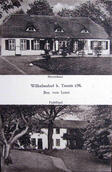Wilhelmshof (Abandoned Village)
The lost village of Wilhelmshof lay south of the connecting road from Woltow to Selpin and was closely tied to the Woltow estate.
For the history of the estate, see this extract from Geschichte des Kirchspiels Basse und aller eingepfarrten Ortschaften [History of Basse Parish and all Places Served from It] by Andreas Parlow:
The history of Wilhelmshof is also the history of the glass factory in Woltow. The businessman and wood merchant Walter Stein from Rostock established the glass factory in Woltow. It began production in 1723, as proven by birth and death entries in the Basse parish records.
In 1724 Heinrich Seitz took over the glassworks and contracted with Stein that “as compensation 400 chests of glass must be delivered yearly, for which Stein will pay two Taler 36 Schilling each; it is also agreed that Stein will immediately regain ownership of the factory if a shipment is late.”
In Güstrow on July 22, 1724 Seitz concluded with Captain Balthasar Friedrich von Halberstadt, the owner of Woltow, an annuity contract until 1730 on the estate and glassworks for 1600 Taler a year. Seitz soon quarrelled with Stein and Halberstadt and left Woltow in 1725, going to his son-in-law in Qualitz, Pastor Engel.
The glass factory was closed in 1732, since in the Basse parish records the last entry for a glassmaker from the glassworks in Woltow occurs on January 31, 1732: glassmaker apprentice Franz Jürgen Lippert married Elisabeth Maria Fenhahn. The workers from the glass factory moved away to the next glassworks, some remained living at the old factory, and others moved in. In 1751 the place was still referred to as the Woltow Glassworks. Among the inhabitants was Gustav Andreas Anners, a well-known name among the Woltow glassmakers.
In 1726, when Captain Balthasar Friedrich von Halberstadt sold Woltow to Ludolph Friedrich von Bassewitz, the glass factory was included in the sale. After Ludolph Friedrich’s death there was a division of the property among his sons in 1757. Woltow and the glass factory (called Philippsdorf after 1732) went to Philipp Cuno Christian von Bassewitz.
On September 22, 1764 he mortgaged his property Philippsdorf to the three heirs of the deceased Prussian Lt. Col. Jacob von Olivet who lived in the area: Sophia Wilhelmina Charlotta von Olivet, wife of Friedrich Casimir Siegfried von Moltke of Samow; Heinrich Adolph Wilhelm von Olivet; and Eleonora Carolina Henriette von Olivet. The mortgage contract was concluded for the sum of 6800 Reichstaler from Trinity Sunday 1765 to Trinity Sunday 1777. Thus Philippsdorf was separated from Woltow and was run as an independent estate. It was also agreed in this mortgage contract that the mortgagees be allowed to change the name Philippsdorf to Wilhelmshof. Since “no suitable house is available,” Philipp Cuno Christian committed himself “to deliver by Trinity Sunday 1765 a fully habitable house upon an already chosen site, built to a floorplan signed by both parties, and having a simple stone roof, large chimney, strong doors, windows, and stoves, plank and stone floors. . .” No tree was to be felled or other building material taken from the area of Philippsdorf for the construction. On June 15, 1765 the estate with its new house was handed over and called Wilhelmshof from that day forward.
Between 1790 and 1793 Wilhemshof was sold to Wedige Gustav von Walsleben, who already owned Woltow. Now the place was called simply Wilhelmshof and was again detached from Samow by this sale.
Wedige Gustav von Walsleben died on March 1, 1796. His heirs sold Wilhelmshof without Woltow to Chamber Councillor Christian Ludwig von Warnstedt, who died in Wilhelmshof on April 11, 1810 and was buried in Basse on April 15 of the same year. His widow Franziska, née Langholz, remained in possession of Wilhelmshof until 1818, when she sold the property to August Carl Gabriel Boldt, who took up residence in May 1819. His brother Wilhelm Christian had been the owner of Samow since 1815.
August Carl Gabriel Boldt was born on February 20, 1788 in Vietgest, son of the local estate owner Joachim Gabriel Friedrich Boldt. He married Caroline Friederike von Meibohm. In 1823 he became Demesne Councillor, died on September 12, 1824 in Wilhelmshof, and was buried in Basse on September 16.
Boldt’s heirs sold Wilhelmshof in 1827 to Carl Wilhelm Albrecht von Quitzow. He was married to Luise Maria Dorothea Franke.
In 1832 Peter Ludwig von Witzendorf was the owner of the estate of Wilhelmshof and Woltow. In Basse on June 1 his daughter Sophia Amalia married Carl Ludwig von Plato, assessor in Lüchow in the Kingdom of Hannover.
Friedrich August Peters became the owner of both Wilhelmshof and Friedrichshof in 1844. Thus Wilhelmshof and Woltow were finally separated. However, Peters does not seem to have lived in Wilhelmshof.
In 1875 Cavalry Captain Johann Friedrich Wilhelm von Uslar was the owner of Wilhelmshof and also lived there. He was married to Alexandrine von Vieregge. A daughter of the couple married Anton Hans Carl von Bülow, owner of the Dessin estate, on April 25, 1879. Another daughter, Anna Elisabeth Adelheid Ottilie Philippine, was confirmed in Basse in 1876. Von Uslar moved to Schwerin, where he died at a very advanced age on June 17, 1907 after his golden wedding anniversary.
Georg Hermann August Gottfried Putensen was the lessee of Wilhelmshof and died there on July 26, 1892. So von Uslar must have left Wilhelmshof before 1892. Putensen’s son Carl Ludwig assumed the lease from his father from 1892 to 1904, when he went to Schlage as hereditary lessee.
Hans Theodor Franz Julius Voss was the next lessee of Wilhelmshof. He was born in Repnitz on October 12, 1869, the son of the local inspector Wilhelm Carl Friedrich Voss. Hans Theodor Voss lost his six-month old daughter on December 15, 1905 and his wife Magdalena Elfriede Bertha, née Beerbaum, in January 1906. She was the daughter of Rudolf Beerbaum, the owner of the Erdmannshöhe estate near Demmin. He had his daughter exhumed in Basse on April 7, 1906 in order to bury her next to his wife in Demmin. Although his lease ran until 1910, he left Wilhelmshof and went as administrator to Groβ Ridsenow. On 28 June 1910 he married in Dobbertin as his second wife a daughter of the chef Gustav Wilhelm Heinrich Schutze.
In December the von Uslar heirs sold the Wilhelmshof estate to the real estate agent Wegner from Rostock, who sold it to Carl Wiese in 1909 for 180,000 Marks. Wiese took up residence in Wilhelmshof but in 1911 sold on the estate with its inventory for 240,000 Marks to Jürgen von Alten, born on October 27, 1889 in Hemmingen near Hannover. He was a nephew of Mr. von der Decken from Reddershof.
In 1928 Werner von Leers was the estate owner and lived in Wilhelmshof with his mother. But von Leers was already gone in 1929 and the real estate agent von Manteuffel bought Wilhelmshof, supposedly paying off von Leers’s creditors. Under von Leers the estate had already been leased to a certain Jahn, who in 1930 bought it off von Manteuffel for 145,000 Marks. After he had reduced the insurance on the buildings by 50%, the right side of the estate complex consisting of three related buildings burned down. Six weeks later the left side, a thatched barn, also burned. Only the horse barn, stock barn, house, an old carriage house, an open pavilion, and chicken sheds were spared.
Thereafter Wilhelmshof passed to a Mr. Fitting, who still owned it in 1938.
In 1921 the estate had an extent of 152 hectares (376 acres).



